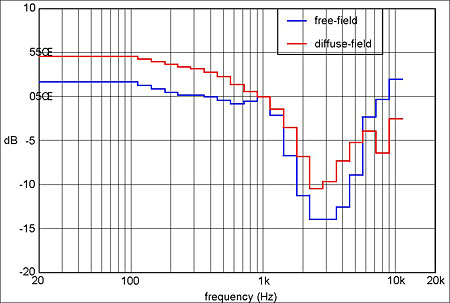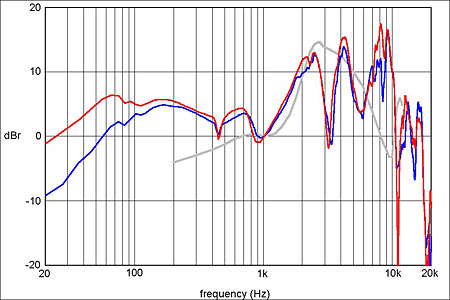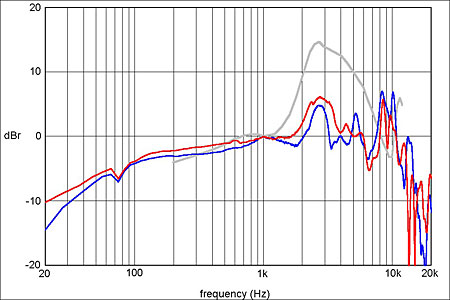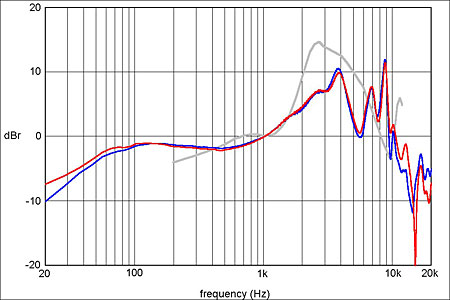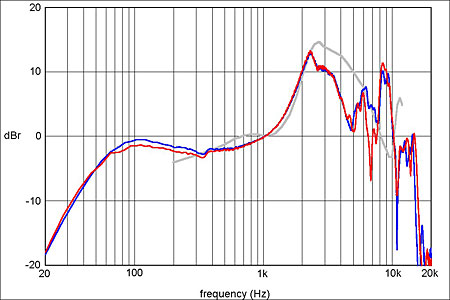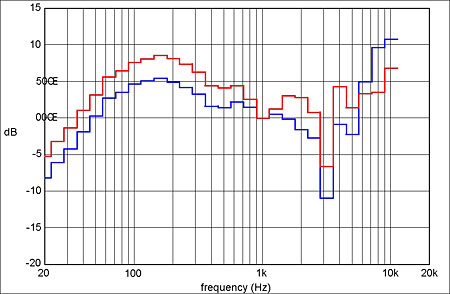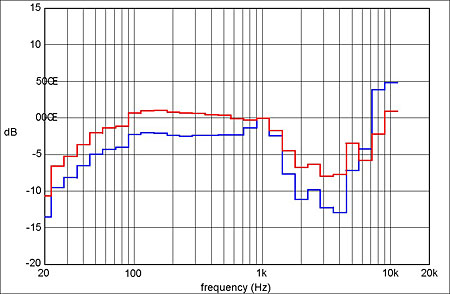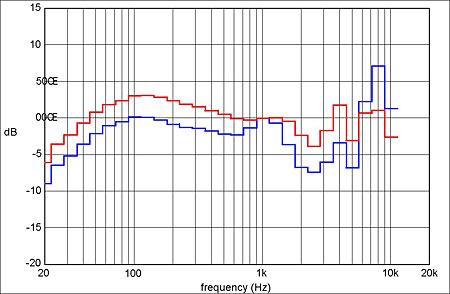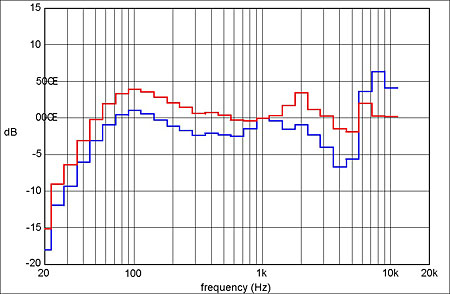Hi. I wasn't home for most of the day today. There have been some interesting posts.
Quote:
Originally Posted by YCH /img/forum/go_quote.gif
- How did you measure the frequency response of your headphones? I'd like to know your setup; did you use a dummy head, or just a simple microphone in free-air?
- Now that you've read the Stereophile article about free-field, diffuse-field, and flat equalization, what are your thoughts on your headphones responses?
On another note, have you tried virtualization effects (Dolby Headphone or similar HRTF algorithms) to help 'externalize' the sound from headphones? I know a lot of people here don't care for it, but I am fan of such post processing effects because it improves the soundstaging and comfort of long listening.
|
Again, I didn't measure them. I only used my ears. Take that for what you think it's worth. If it's not worth anything to you, that's fine, I understand.
In regards to the Stereophile article and what I think about my headphone's.. I thought it was likely that the response of the Audio-Technica ATH AD700, which the author preferred, might be somewhat similar to that of the Sennheiser HD600. So, out of curiosity, I checked to see what the HeadRoom graphs had to say..
As I'm sure I've mentioned in previous posts, I sometimes find the last octave of the HD600 particularly bothersome, especially right around 12 KHz. It's been my observation that a large portion of measurements at the HeadRoom site possess a large dip right around this area. The HD600 does too, but most of this top octave is still much higher than most of these (including even many of Sennheiser's most popular 'phones), and this is the case with the ATH AD700.
Here's a few popular 'phones, picked almost entirely at random:
..See what I mean? Interesting.
Anyway, as for the rest of the article, it only confirms my previous thoughts that obtaining a neutral sound at the ear is extremely difficult, if not impossible. Among other things, there simply aren't enough standards, and manufacturers won't stick to them. Frequency response alone varies wildly from headphone to headphone, and what should be considered as flat has been highly debated since their inception, and it seems to me as though this largely continues to remain a mystery for the most part, even today. As far as the diffuse-field curves suggested by Theile, headphones labeled by their manufacturers as "diffuse-field equalized" often seem to be anything but.
I'll post some of the most interesting excerpts from that article here, just because..
[size=xx-small]"If we are using headphones in place of speakers, then it might seem logical that the headphone's frequency response should imitate that of a sound source at head level, 30° off the median plane— ie, where the loudspeaker would be in a conventional stereo setup. In headphone parlance, this is termed the free-field or FF response assumption. Two such responses are shown in fig.2: one from research conducted in the 1970s by Shaw (blue trace), the results of which were later published in numerical form (footnote 3); and the second, from the publicly available HRTFs measured at MIT using the KEMAR manikin (red). There are significant differences between the two, as there are in the results of other researchers, but a big peak in response between 2 and 3kHz is a consistent feature, as is a progressive decline thereafter except for a smaller peak at around 13kHz. (Note that these are eardrum responses, such as we expect to measure using an artificial ear with an eardrum simulator. Some HRTFs and headphone frequency responses are so-called blocked meatus measurements, obtained with the ear canal closed off. It is important to distinguish which type of response you are looking at; they are not equivalent.)
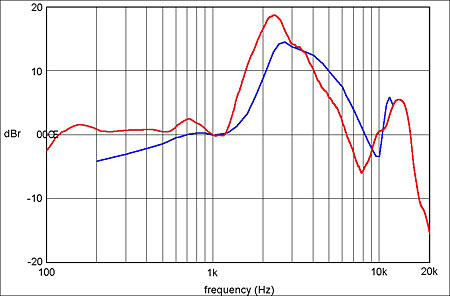
Fig.2 Frequency responses at the nearer eardrum for a sound source at head height, 30° off the median plane, according to Shaw (blue trace) and the KEMAR manikin (red).
Self-evident as the correctness of the FF-response assumption may seem, it came under concerted attack in the 1980s, principally through the work of Günther Theile at the Institut für Rundfunktechnik (IRT) in Germany (footnote 4). Using a Gestalt model of auditory perception, Theile argued that a free-field headphone frequency response would be appropriate only if the stereo image were perceived to be forward of the listener, as it is when reproduced over loudspeakers. As everyone who has used headphones knows, this is not the case—the image is generally perceived to be either inside or close around the head. Because of this, Theile claimed, a headphone with a free-field frequency response is perceived as spectrally colored.
The argument is made clearer by fig.3, which paraphrases the Gestalt perception model proposed by Theile. It shows how, in passing through the outer ear, sound is subject to HRTF spectral modification, H(s). This spectral modification is used by the brain to help determine the sound source's location, and then inverse filtering, H'(s), is applied to prevent the timbre of the sound from being distorted. If H'(s) is not the inverse of H(s), as Theile argued is the case with free-field headphone response because the image is not perceived as being forward of the listener, then cancellation is imperfect and, as a result, the perceived sound is colored.
Fig.3 Gestalt hearing model used by Theile to argue against the use of free-field headphone response.
Theile contended that, because the headphone image has no preferred direction, the ideal headphone frequency response would be that which pertains at the ear in a diffuse soundfield, where sound arrives equally from all directions. This diffuse-field, or DF, response is significantly different from the FF response, and Theile went on to demonstrate its superiority in experiments in which headphones were electronically equalized to have either FF or DF responses.
If you suppose that, as a result of Theile's work, there is now a headphone-industry consensus that the DF response assumption is the correct one, prepare yourself for disappointment. Headphones continue to espouse widely differing response philosophies: some close to FF, some close to DF, and others nearer to flat. Which is "right" remains a bone of contention.
From the point of view of those who measure headphones, then, there is no hope of being able to apply a universally accepted correction to generate a "flat is correct" response. The best we can do is apply both FF and DF corrections and hope to learn by experience which, if either, truly correlates with the best subjective performance. Until recently, such corrections were not generally available for artificial ears with eardrum simulators, but recent work by Hammershøi and Møller has plugged that gap (footnote 5). Their third-octave corrections, normalized to 0dB at 1kHz, are shown in fig.4.
Fig.4 Third-octave free-field and diffuse-field corrections for artificial ears with eardrum simulators, after Hammershøi and Møller.
Let's apply these corrections to some headphone measurements and see what falls out. Fig.5 shows uncorrected frequency responses, measured using my artificial ear setup, for four midpriced headphones I tested last fall as part of a group review for Hi-Fi News: the AKG K530, Audio-Technica ATH-AD700, Beyerdynamic DT440, and Grado SR80. The blue trace is the left capsule response, the red trace the right capsule response; grayed-out in the background of each graph is the Shaw 30° free-field response as a point of reference. As you can see, the responses of these four 'phones differ quite significantly, the obvious oddball being the Audio-Technica—which was also my clear favorite in the subjective testing.
Fig.5 Uncorrected left (blue trace) and right (red) capsule responses for four midprice headphones: (a) AKG K530, (b) Audio-Technica ATH-AD700, (c) Beyerdynamic DT440, and (d) Grado SR80.
Fig.6 shows the result of converting one channel's response to third-octave form and applying Hammershøi and Møller's FF and DF corrections (red and blue traces, respectively). If we assume that the DF-corrected response is the more relevant, as Theile suggests, then the flattest results are recorded by the Beyer and Grado, the biggest difference between them occurring around 2kHz, where the Grado apparently tries to follow the Shaw FF curve and the Beyer does not. Separate nearfield measurements of each model's diaphragm behavior off the artificial ear showed the Grado's cumulative spectral-decay waterfall to have a large resonant ridge at this frequency, which perhaps explains why, in the listening tests, I found the SR80's tonal balance much too forward in the upper mids. Without so marked a response peak—and with a very clean waterfall plot— the Beyer was preferred.
Fig.6 Free-field (red trace) and diffuse field (blue) corrections applied to the responses of fig.5.
But my clear favorite overall, by a large margin, was the Audio-Technica. Its more laid-back tonal balance was much more like what I'm used to hearing from speakers, and its imaging was remarkably spacious, to an extent that I had never heard from headphones before. Already, then, I am beginning to suspect that a response somewhere between DF and flat is actually optimal. But these are early days; as other headphones pass through my lab, it will become clearer whether this is indeed the case.[/size]
Okay, well, it turns out that was mostly the 3rd page.. lol.
Oh, yeah.. I've tried Dolby Headphone, as well as a ton of other stuff in the past (everything I could possibly find). In the end, as far as using these kinds of plugins the majority of the time on a regular basis, it just doesn't do it for me. I realize what these effects are attempting to do, and understand for the most part over all how they're doing it, and while it does help 'externalize' the sound from my head, I also find it unnatural and it quickly becomes tiresome for me in a way. It's been my observation that these effects which attempt to include reverb in their algorithms sound very artificial. I'm not exactly sure why this is, but I'd be curious to know if there have been any studies performed in regards to this matter, as I know there are a lot of people who feel this same way about DSP's like Dolby HP.
I did end up finding the "Bauer stereophonic-to-binaural DSP" extremely useful though, and I always use it with Foobar. Of course, after listening this way for so long, it's tough to go without it. While I think it often has its drawbacks, it definitely alleviates some of the fatigue and unnaturalness due to the inherent problem of extreme stereo separation with headphones. I often listen for hours on end, so I think it helps, for the most part.
Also, I find many of ADD's comments particularly interesting. And not simply because we share similar experiences and views. I have to do a few things around the house though, so I'll bbl.


